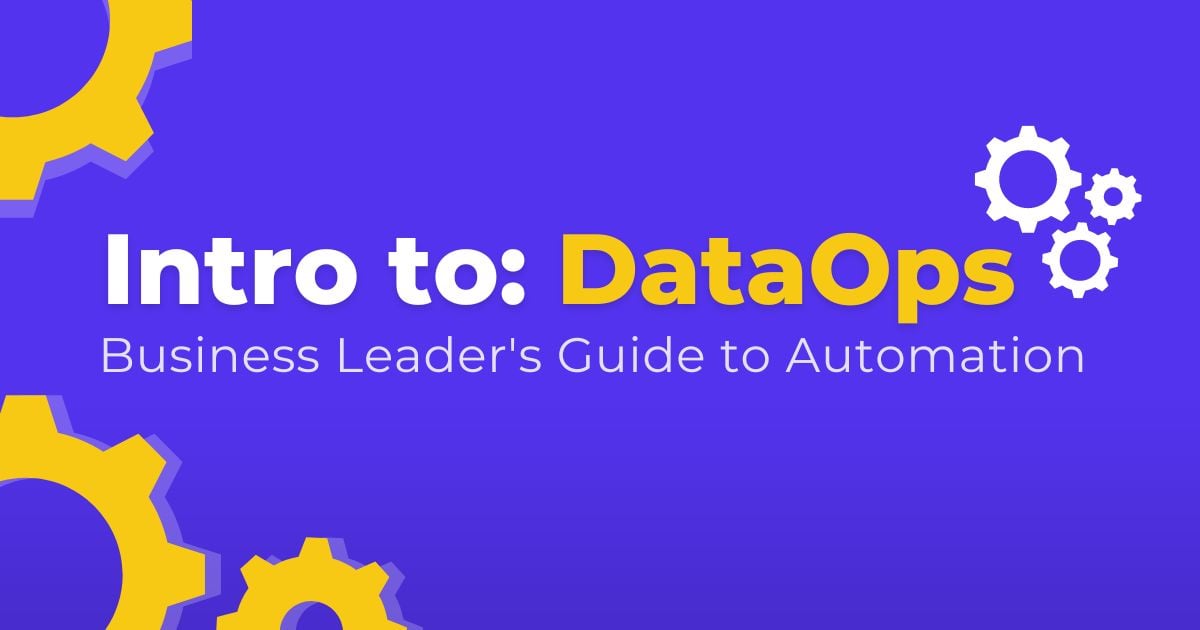Tableau Conference 2025 | Know Before You Go
If you’re a data enthusiast, analytics professional, or just someone curious about Tableau’s latest innovations, the Tableau Conference 2025 is your...
5 min read
 Luke Komiskey
May 14, 2023
Luke Komiskey
May 14, 2023

Welcome to the world of DataOps, a game-changing approach that empowers organizations to accelerate their data-driven initiatives, enhance collaboration, and streamline data pipelines in the era of modern data stacks. As a leading DataOps-centric reporting platform, DataDrive is here to help you navigate this exciting realm and show you how DataOps can revolutionize the way your business manages and leverages data.
Let's dive in and explore DataOps together!
DataOps, short for Data Operations, is a set of practices and methodologies designed to improve the efficiency, speed, and reliability of data analytics and processing pipelines. But what is DataOps in simple terms? Think of it as the bridge between data engineering, data science, and business operations, facilitating seamless collaboration and more agile decision-making processes.
When comparing DataOps vs. DevOps, it's essential to understand that DataOps is inspired by DevOps principles, applying them to the data domain. So, while DevOps focuses on software development and deployment where each iteration of code is mostly automatic, DataOps specifically targets data management and analytics, which brings additional challenges due to most data systems being dependent on previous iterations of code.
Now that you have a basic understanding of DataOps, you might be wondering: Why do we need DataOps? What problem does DataOps solve? Here are some key reasons why DataOps is essential for modern businesses:
To fully grasp the DataOps methodology, it's essential to understand its key components in greater detail:
DataOps focuses on fostering a culture of collaboration and communication among various teams, including data engineers, data scientists, analysts, and business stakeholders. This cross-functional collaboration ensures that all parties are aligned on goals and can work effectively together, enhancing the overall efficiency of the data management process.
DataOps employs automation technologies to handle repetitive tasks in data pipelines, such as data ingestion, transformation, and validation. By reducing manual intervention, organizations can minimize the risk of human errors, increase the speed of data processing, and maintain consistent data quality.
In a DataOps framework, data and code changes are frequently integrated, tested, and deployed, allowing for rapid iteration and delivery of data products. By adopting CI/CD practices, organizations can quickly respond to changing business needs, reduce the time to market for data-driven insights, and ensure data products maintain high quality.
DataOps promotes transparency in data pipelines by continuously monitoring their performance, reliability, and accuracy. This includes tracking metrics, setting up alerts for potential issues, and providing a comprehensive view of the data pipeline's health. Monitoring and observability enable teams to identify and address issues proactively, ensuring the delivery of accurate and reliable data insights.
DataOps emphasizes the importance of version control for both data and code. By tracking changes and maintaining a history of modifications, teams can collaborate more effectively, roll back to previous versions if necessary, and ensure that they are working with the most up-to-date and accurate data. Say goodbye to custom SQL queries floating around inboxes!
In a DataOps framework, data pipelines and processes are designed to be modular and reusable. This approach promotes code reusability, allowing teams to repurpose existing components and streamline the development process. By leveraging modular, reusable components, organizations can iterate more quickly and reduce development time.
DataOps embraces scalable, adaptable technologies and architectures that can accommodate the rapidly changing needs of data-driven organizations. This includes supporting the growth of data volumes, adding new data sources, and adjusting to changing business requirements. By adopting adaptable and scalable solutions, businesses can stay agile and responsive in the face of evolving data demands.
By implementing these key components within a DataOps framework, organizations can create a robust, agile, and efficient data management environment that delivers high-quality, timely data-driven insights.
Ready to dive into DataOps? Here's how to get started and implement DataOps effectively:
Embracing DataOps can propel your organization to new heights of efficiency, agility, and data-driven success. At DataDrive, we're here to support your journey every step of the way. Explore our DataOps-centric reporting platform and take the first step towards a more streamlined, cost-effective, and data-driven future. With DataOps by your side, the sky's the limit!
DataDrive has helped over 150 organizations unlock the full potential of their data and our Analytics Accelerator reporting platform - which incorporates DataOps best practices - allows organizations to focus on their core business with a new data advantage.
What is DataOps vs DevOps?
While DataOps and DevOps share some principles, they focus on different domains. DataOps is inspired by DevOps but specifically targets data management and analytics, whereas DevOps focuses on software development and deployment.
What is DataOps methodology?
The DataOps methodology is an approach that combines principles from Agile development, DevOps, and statistical process control to create an iterative, collaborative, and continuously improving data environment.
What are DataOps principles?
Key DataOps principles include collaboration, automation, Continuous Integration and Deployment (CI/CD), monitoring and observability, version control, modularity and reusability, and adaptability and scalability.
What tools are used in DataOps?
Popular DataOps tools include git, data cataloging & collaboration tools, dbt, Apache Airflow, and many others that support automation, version control, and monitoring.
What skills are required for DataOps?
Essential skills for DataOps professionals include data engineering fundamentals, data science and analysis skills, programming experience, project management techniques, and a deep understanding of the DataOps methodology.
What problem does DataOps solve?
DataOps solves several challenges related to data management, such as improving data quality, streamlining data pipelines, and fostering collaboration between data teams and business stakeholders.
Why do we need DataOps?
DataOps is essential for modern businesses to efficiently manage growing volumes of data, improve data-driven decision-making, and maintain a competitive edge in the market.
What are the stages of DataOps?
The stages of DataOps encompass data ingestion, data transformation, data validation, data storage, data analysis, and data visualization.
How do you implement DataOps?
Implementing DataOps involves assessing your organization's data maturity, assembling a cross-functional team, adopting Agile methodologies, implementing data governance, and leveraging the right tools and technologies.
What is the best way to get started with DataOps?
The best way to get started with DataOps is to understand its principles, assess your organization's current data landscape, and create a roadmap for implementing DataOps best practices. Reach out to DataDrive for a fast way to achieve your data advantage!
What are the 5 phases of the data lifecycle?
The five phases of the data lifecycle include data collection, data processing, data analysis, data storage, and data archiving or disposal. DataOps streamlines these phases to ensure high-quality, timely data-driven insights.
-2.gif)
If you’re a data enthusiast, analytics professional, or just someone curious about Tableau’s latest innovations, the Tableau Conference 2025 is your...

Tableau Plus is the new premium offering from Tableau, a leading data visualization and business intelligence platform. It builds upon the...

If you've spent any time working with Tableau, you've likely encountered the dreaded "Cannot Mix Aggregate and Non-Aggregate Arguments" error. It's a...